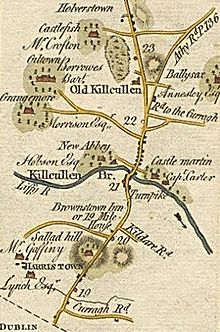User:SeoR/Sandbox/OldKilcullen
Old Kilcullen
Sean Chill Chuilinn | |
|---|---|
Town | |
| Country | |
| Province | Leinster |
| County | County Kildare |
| Time zone | UTC+0 (WET) |
| • Summer (DST) | UTC-1 (IST (WEST)) |

Old Kilcullen, formerly Kilcullen (Cill Chuilinn, "the Church of the Holly" in Irish), is the name of both a settled area and a religious archaelogical site in County Kildare, Ireland, formerly the site of a walled town and ecclesiatical settlement. The original settlement gave its name to the substantial surrounding civil parish, and barony.
The urban centre of the area moved about 2km west and slightly north to Kilcullen Bridge on the River Liffey, often now simply known as Kilcullen, over the centuries following the construction of a bridge there in 1319. Old Kilcullen is also under 5km from Newbridge and around 13km from Naas.
Old Kilcullen is the site of a round tower and a decorated High Cross, and another historic site, Dun Ailinne, is on the next hill to the west, Knockaulin.
Location and access[edit]

Old Kilcullen is situated on a hill around 2 kilometres from Kilcullen Bridge[1]. It can be reached from a number of minor roads to the east off the Kilcullen-Athy road, or from an exit in the northbound carriageway of the Dublin-Waterford road. There is just one official path to the site, and a small car park at its entrance.
At ground level today, the site appears to be confined to a churchyard with surviving stone features at the top of a gently sloping hill, but aerial and ground surveys have shown a far greater extent to the former settlement, including embankments on the slopes of the hill.
The site has no public transport access but Kilcullen Bridge is served by two long-distance bus services. Old Kilcullen is under 5km from Newbridge and around 13km from Naas.
History[edit]
Kilcullen begun as a monastic settlement, in around 458. The choice of location for the settlement was perhaps related to the nearby Dun Ailinne, a ceremonial and possible palace site related to the kings of Leinster, though Dun Ailinne long predates any known settlement at Old Kilcullen. The settlement was assigned a bishop, (St.) Isernine, by St. Patrick, and he was succeeded by MacTail or Mactalius.
Old Kilcullen was raided by Vikings, landing at the location of the modern town, at least twice, in 932 and 936.
The town reached its peak in early Anglo-Norman times, as a walled town with seven gates and seven, or perhaps eight, roads, and regular markets. There was also some form of castle, which was by the time of Henry VIII held by the Fitzeustace family, who held for a time the title Baron of Kilcullen.
Kilcullen Bridge[edit]

The new town officially known and mapped as Kilcullen Bridge began to develop after 1319 when a bridge across the River Liffey was constructed at that place by a canon, Maurice Jakis, of Kildare Cathedral. It took over, over succeeding centuries, from the old centre, though until the late 19th century, Old Kilcullen townland had a greater population than Kilcullen Bridge. Originally, as shown on maps even as late as the late 1700s, the new settlement was wholly on the eastern bank of the Liffey.
Later years[edit]
The fortification here was initially held by the parlimentary forces in 1641, but later taken by the Royalist army, and then recaptured and burned by the parlimentarians in 1647.
In 1798, this was the site of the Battle of Kilcullen, the first phase of which was won by the rebels, before they were driven out, and back to Knockaulin (Dun Ailinne) by General Dundas. During the battle, the round tower was damaged[1] and subsequently stablised in its current form.
At some point, the settlement, now just a small village, lost the market to Kilcullen Bridge, retaining a small twice-yearly fair. It retained a small church, by then Church of Ireland, until some time in the 18th century, and revenue from this went to support two canons of Christchurch Cathedral, Dublin.
Activity was also lost as the main road from Dublin to Carlow (via Athy) diverted away from the hill.
The round tower was taken under State care in the late 19th century.
Current situation[edit]
Little now remains visible beyond the walled churchyard, which contains the damaged round tower, the remnants of a church, two Irish High Crosses, the base of another large cross, and many graves. However, further traces of structures can be seen in aerial photography.
In addition to the historic area, there are a few homes and farms, a public house, and a Kildare County Council reservoir.
External sources[edit]
- Kilcullen(-Bridge), Co. Kildare, Ireland: (monthly publication, 1970s to today), various issues
